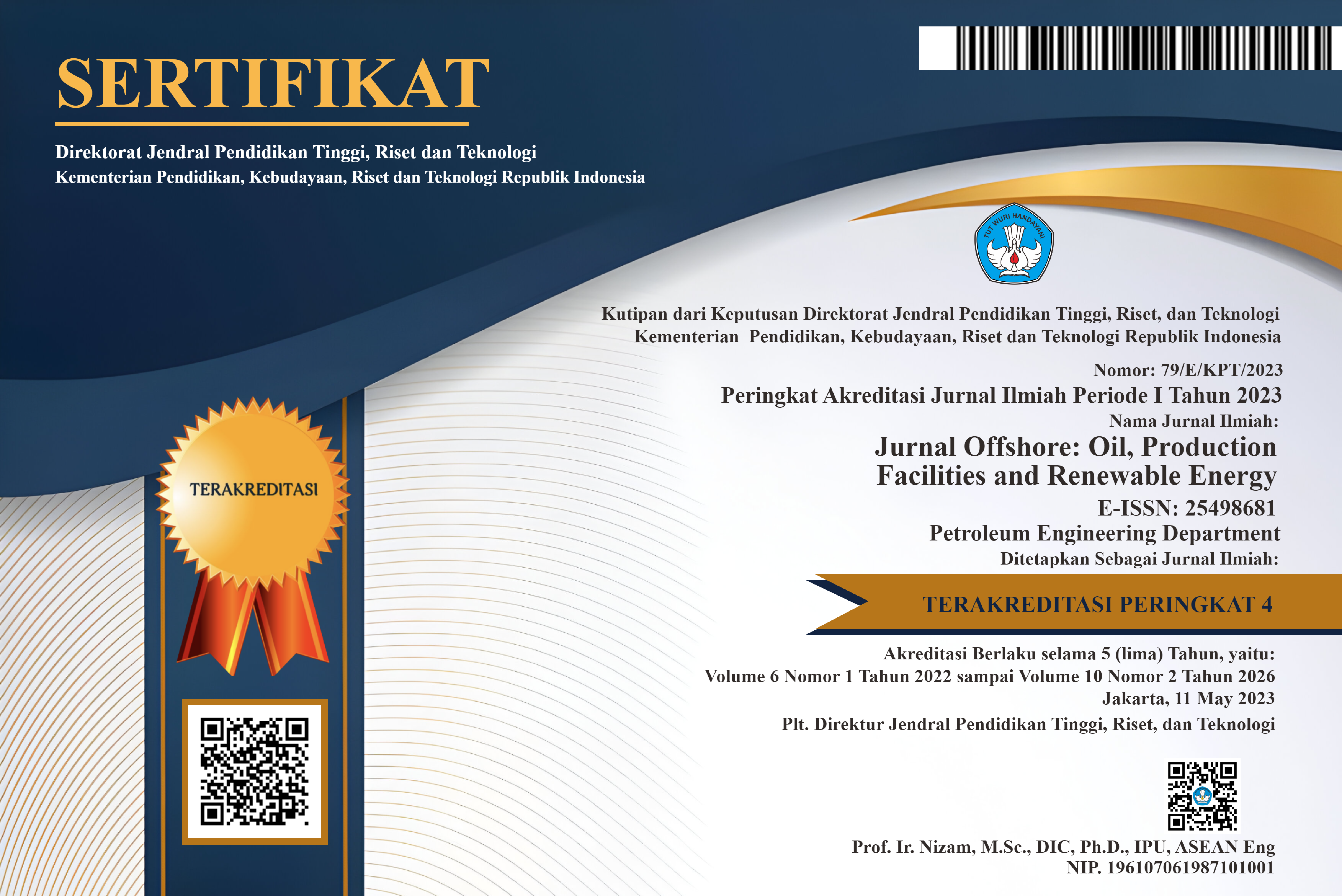Rencana Pengembangan Lapangan Gas Metana Batubara Dangkal (Shallow CBM) di Daerah Ida Manggala, Rantau, Kabupaten Hulu Sungai Selatan Kalimantan Selatan
DOI:
https://doi.org/10.30588/jo.v2i1.351Keywords:
gas content, gas in place, reservoir batubara, dewatering, pilot well, coal reservoirAbstract
Potensi kandungan gas batubara (Gas Content) Idamanggala, Rantau, Kalimantan Selatan berkisar 6,72 m3/ton. Sumberdaya gas batubara (Gas in Place/GIP) Rantau, Kalimantan Selatan 0,002 tcf (saturasi gas 90%), kisaran kedalaman 50-150 meter. Gas Metana Batubara (GMB) diproduksi dengan cara terlebih dahulu merekayasa batubara sebagai reservoir agar diperoleh cukup ruang sebagai jalan keluarnya gas metana. Proses rekayasa diawali dengan memproduksi air (dewatering) agar terjadi perubahan keseimbangan mekanika. Setelah tekanan turun, gas batubara akan keluar dari matrik batubara. Gas metana kemudian mengalir melalui rekahan batubara dan akhirnya keluar menuju lubang sumur. Puncak produksi Gas Metana Batubara (GMB) bervariasi antara dua minggu sampai dengan tiga tahun. Rencana pengembangan lapangan dimulai dari tiga tahun pertama dengan melakukan lima sumur pilot (pilot well). Pemboran pilot dilakukan untuk mengenal dimensi seam dan kualitasnya, baik secara lateral maupun vertikal. Apabila regulasi pemerintah sesuai dan memungkinkan untuk memulai pengembangan, maka pengembangan sumur produksi dapat dimulai pada tahun 2021. Pengembangan Lapangan Gas Batubara Daerah Rantau Kalimantan Selatan diprioritaskan untuk kebutuhan pasar lokal yaitu kebutuhan tenaga listrik setempat baik industri maupun rumah tangga dan jika memungkinan dapat dialirkan melalui pipa untuk perusahaan gas negara.
Coal gas content potential (Gas Content) Idamanggala, Rantau, South Kalimantan is around 6.72 m3/ton. Rantau coal gas resources (Gas in Place/GIP), South Kalimantan 0.002 tcf (90% gas saturation), range of depths from 50-150 meters. Coal Methane Gas (GMB) is produced by first engineering coal as a reservoir in order to obtain enough space as a way out of methane gas. The engineering process begins with producing water (dewatering) so that there is a change in mechanical balance. After the pressure drops, coal gas will come out of the coal matrix. Methane gas then flows through the coal fractures and finally exits into the wellbore. The peak production of Coal Methane Gas (GMB) varies between two weeks to three years. The field development plan starts from the first three years by conducting five pilot wells. Pilot drilling is carried out to recognize the dimensions of seam and its quality, both laterally and vertically. If government regulations are appropriate and allow to start development, the development of production wells can begin in 2021. The development of the South Kalimantan Overseas Coal Coal Field Development is prioritized for the needs of the local market, namely the needs of local electricity both industrial and household and if possible can be channeled through pipes for the state gas company.
References
Ayes, W.B., 2002, Coalbed gas systems, resources, and production and a review of contrasting cases from the San Juan and Powder River basins. AAPG Bulletin, 86: 1853-1890.Butland, C.I. and Moore, T.A., in review. Biogenic coal seam gas reservoirs in New Zealand: A preliminary assessment. International Journal of Coal Geology.
Australia Standard AS 3980-1999, 1999, Guide to the determination of gas content of coal – Direct desorption method, Standards Association of Australia, 36 p.
Badan Geologi, 2012, Potensi dan Pengembangan Coal Bed Methane, Indonesia. ISBN 978-602-7928-00-8. Kementerian ESDM.
Basuki Rahmad, Sugeng Raharjo, Eko Widi Pramudiohadi, Ediyanto, 2017. Kajian Sum-berdaya Gas Metana Untuk Pengembangan Lapangan Gas Metana Batubara di Daerah Idamanggala, Kec. Sungai Raya, Kab. Hulu Sungai Selatan Kalimantan Selatan Ber-dasarkan Kualitas dan Mikroskopis Batubara. Seminar Nasional Teknik Kimia “Kejuangan”. ISSN 1693-4393.
Eddy, Greg E,. Rightmire,. Craig, T., Byrer, Charles W., 1982, Relationship of Methane Content of Coal Rank and Depth: Theoretical vs. Observed, Society of Petroleum Engineer, U.S. Dept. of Energy.
Fraillon, M., 2000. The Numerical Modelling of Fluid Flow in Coal as a Porous Media.
Hadiyanto, Stevens, Scott, H., 2004, Coalbed Methane Indicators and Basin Evaluation, Society of Petroleum Engineer.
Kristadi, H.J., Dati, D.W., 2012. Gas Metana Batubara. Pusat Penelitian dan Pengem-bangan Teknologi Minyak dan Gas Bumi PPTMGB “Lemigas”. Kementerian ESDM. ISBN 978-979-8218-26-20.
Moore, Tim, A., 2007, Exploration and Development of a Low Rank, Biogenically-Derived Coalbed Methane Prospect, Huntly Coalfield, New Zealand, Solid Energy NZ Ltd, Workshop CBM Indonesia, Bali 4-5 July 2007.
Ott, H.L., 1987. The Kutai Basin a Unique Structural History, Proceeding IPA 16th Ann,Conv. p.307-316.
Nelson, C. R., 1999, Effects of Coalbed Reservoir Property Analysis Methods on Gas-In-Places Estimates, Society of Petroleum Engineer, West Virginia, 21-22 October, 1999.
Stach, E., Mackowsky, M., Th., Teichmuller, M., Tailor, G.H., Chandra, D. & Techmuller,R., 1982. Stach’s Textbook of Coal Petrology 3th edition. Gebr. Borntraeger, Berlin-Stutgart. p.38-47.
Suarez-Ruiz,I., Crelling,J.C., 2008. Applied Coal . Petrology. The Role of Petrology in Coal Utilization. Elsevier Ltd All rights reserved.
Downloads
Published
How to Cite
Issue
Section
License
Authors retain copyright and grant the Jurnal Offshore right of first publication with the work simultaneously licensed under a Creative Commons Attribution 4.0 International License that allows others to share (copy and redistribute the material in any medium or format) and adapt (remix, transform, and build upon the material) the work for any purpose, even commercially with an acknowledgement of the work's authorship and initial publication in Jurnal Offshore. Authors are able to enter into separate, additional contractual arrangements for the non-exclusive distribution of the journal's published version of the work (e.g., post it to an institutional repository or publish it in a book), with an acknowledgement of its initial publication in Jurnal Offshore. Authors are permitted and encouraged to post their work online (e.g., in institutional repositories or on their website) prior to and during the submission process, as it can lead to productive exchanges, as well as earlier and greater citation of published work (See The Effect of Open Access).















